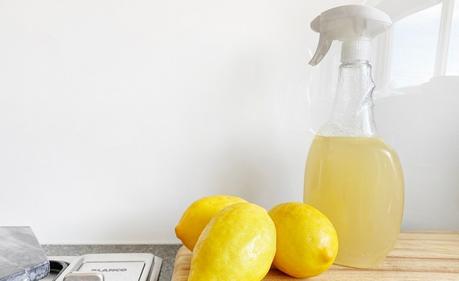
Thorough cleaning is an essential part of maintaining a healthy home, especially in the midst of a pandemic. The world has become increasingly mindful about disinfecting surfaces and using cleaning supplies liberally. However, for those who have asthma or lung disease, the increased use of store-bought cleaning supplies can induce some adverse side effects.
Cleaning should be a satisfying process, not one that causes discomfort or harm. To keep loved ones with lung sensitivities safe and comfortable, it's a good idea to steer clear of store-bought cleaning supplies that include potentially harmful chemicals. Instead, consider making your own all-natural products that clean effectively without the potentially harmful after-effects.
We've compiled some tips, best practices, and recipes for DIY lung-safe cleaning products to make the transition from artificial to natural as seamless as possible.
What to avoid
Many of the chemicals that are tolerable to people without lung disease can exacerbate COPD symptoms in those suffering from lung diseases.
While it's a good rule of thumb to avoid store-bought cleaners altogether, there are certain ingredients and products that can put up some red flags if you still plan to purchase certain products in store. These include:
- Ammonia: Despite its ability to clean well, it irritates tissue and can induce discomfort in those suffering from lung conditions.
- Bleach: We all know bleach is a strong substance. That said, it also has a negative impact on lung health when inhaled. Remember never to combine ammonia and bleach, which creates a highly toxic and harmful gas that could be life-threatening.
- Chlorine: Extended exposure to chlorine is known to irritate the skin, harm thyroid function, and make breathing difficult in those with COPD.
- Phthalates (fragrances): Many store-bought products with fragrances trigger asthma symptoms, among other breathing difficulties.
- Sodium hydroxide (oven cleaners): Exposure to sodium hydroxide can result in throat and breathing discomfort, among other unpleasant side effects.
- Aerosol sprays: Aerosol sprays tend to be packed with volatile organic compounds (VOCs), known to result in chronic respiratory issues.
Unfortunately, it's hard to trust most store-bought cleaning agents, as many market their products as "green" or "eco-friendly" without actually removing certain substances that are harmful to lung health or the environment. When in doubt, avoid store-bought altogether and choose a homemade option that uses simple and natural ingredients.


Materials needed for homemade lung-safe cleaning supplies
You may be wondering how it's possible to make all of your go-to cleaning supplies without relying on store-bought brands. The reality is that many of the household supplies that we use on a daily basis can be repurposed to create effective disinfectants and stain removers.
Some of these multi-purpose household items include:
- White vinegar
- Baking soda
- Isopropyl alcohol
- Hydrogen peroxide
- Castile soap
- Salt
- Citrus (lemon & lime juice)
If you've ever used baking soda to clean your white shoes or to scrub the nooks and crannies of your bathroom, you probably already know how powerful of a stain remover it can be. Many of these items can be combined together or mixed with water to create an easy, all-natural cleaning solution.
You may have noticed that the products above are relatively scent-free or only contain a mild scent. While this is a good sign, as many cleaning solutions use toxic chemicals to produce a smell, you may want your spaces to smell nice after cleaning them.
Thankfully, lung-safe essential oils can be combined with homemade solutions to leave your surfaces smelling nice. These include:
Recipes for DIY lung-safe cleaning solutions
We use several types of cleaning products in our daily lives, from sprays to wipes to soaps. It may seem shocking that all of these commonly store-bought goods can be made right in the comfort of your own home with your own lung-safe ingredients. Let's dive into how to create all of your cleaning necessities from scratch easily.
1. Disinfectant wipes
It may come as a surprise that disinfectant wipes can be made at home rather than purchased in a plastic tube from the store. To get started, you'll need:
- A bowl or tub (with a lid)
- Washcloths or dishrags
- White vinegar, hydrogen peroxide, or isopropyl alcohol
- Castile soap
- Your favorite essential oils
To make the wipes, start by adding one part vinegar, hydrogen peroxide, or isopropyl alcohol and one part water to your bowl. Add a few drops of Castile soap, followed by a few drops of essential oil if you want to add a fragrance.
After mixing everything together:
- Fold your rags and put them in the mixture.
- Cover the bowl and store the soaking rags in a dry, cool place. Once the rags have thoroughly soaked up the mixture, they're ready to disinfect your surfaces.
- Wash and reuse the rags for next time.
This lung-safe alternative to disinfectant wipes won't only keep you breathing freely, but they'll also save you money and help you live sustainably by cutting down on waste.
2. Glass cleaner
You don't need a chemical-infused aerosol spray bottle from the store to remove fingerprints, smudges, and dirt from your mirrors and windows. Here's what you need for a homemade, lung-safe alternative:
- Spray bottle
- White vinegar
- Warm water
- Essential oils (optional)
Making glass cleaner is simple. All you need to do is combine equal parts of warm water and vinegar in the spray bottle, adding a few drops of whatever essential oils you want. Stir everything together, and you're ready to make streaks and smudges disappear.
3. All-purpose cleaner
We all have a go-to bottle of all-purpose cleaner that can be used on nearly any surface. Since these tend to use harmful chemicals to eat away at collected grime, it's a good idea to transition to a lung-safe cleaning alternative. Keep in mind that this recipe disinfects and avoids symptom flare-ups when used on all surfaces except for marble:
- Spray bottle
- 2 cups vinegar
- 2 cups water
- Citrus peels (optional)
While you can make a totally scent-free mixture by simply combining water and vinegar in a spray bottle, if you want your cleaner to leave a natural citrus scent, you'll want to prepare ahead of time.
To diffuse the citrus peels into the mixture, combine the peels and the vinegar in a covered mason jar for one to two weeks. You'll then want to strain the mixture, toss the citrus peels, and combine the citrus-infused vinegar with the water in a spray bottle. You might want to test this mixture on a couple of different surfaces to ensure it's right for you.
4. Carpet cleaner
Keeping carpets clean is no easy task. Accidents such as tracked-in dirt, liquid spills, and dropped food happen all the time and require quick action. For a spot-treating carpet cleaner that doesn't disrupt lung health, consider the following recipe:
- Spray bottle
- 1 cup water
- ½ cup white vinegar
- 1 teaspoon salt
- Several drops of essential oil (optional)
Start by adding the water and vinegar to your spray bottle. After stirring in the salt and essential oils, shake the mixture until everything is thoroughly combined. You're ready to fight back against the dirt of daily life.
5. Scouring cleaner
Sometimes, you need something a little stronger to remove dry, stiff material that's gotten stuck on your kitchen's pots and pans. Like many other cleaners, store-bought versions contain harsh chemicals known to induce COPD symptoms. Here's a simple recipe that gets the job done without causing lung discomfort:
All you have to do is stir the baking soda and water together until you have a nice paste. Rub this paste onto the surface you want to clean and let it sit for a few minutes. Rinse it off with warm water and scrub off whatever dirt and grime are remaining.
Here's a beautiful infographic to sum up our lung-safe cleaning tips:


How to keep your lungs safe while cleaning
If you can't avoid using store-bought cleaning products that include potentially harmful chemicals, consider the following tips to keep your lungs safe and healthy.
- Cover your face and mouth: If the pandemic has taught us one thing, it's how to wear a face mask properly. Covering your mouth and nose can help you inhale fewer chemicals known to induce asthma symptoms and COPD.
- Keep scents to a minimum: Unless you're using natural lung-safe scents, it's a good habit to avoid cleaning products with added fragrances. These can cause shortness of breath, among other respiratory issues.
- Ventilation is key: Turn on the fans and open the windows-cleaning in an enclosed area condenses the fumes you inhale, often resulting in more severe respiratory reactions.
- Control moisture: Asthma-inducing mold thrives in moisture. Use a dehumidifier or a vinegar spray to keep the moisture in your living space to a minimum.
- Dust regularly: Remove dust from items that are rarely touched every week to reduce the number of particles you inhale. There's no need to hyper-fixate on little bits of dust, but it can quickly accumulate and worsen breathing problems.
Conclusion
Cleaning products may just be one cause of worsening lung disease symptoms. Remember to regularly talk to your doctor about the chemicals and particles you come into regular contact with to diagnose and treat the causes of symptom flare-ups. This healthy habit might save you from many future troubles and keep your family safe.
If you feel that we could've added some more tips, please write in the comment section below.
Featured image: Mockup psd created by freepik - www.freepik.comHappy cleaning!

